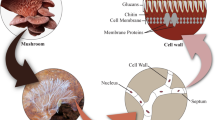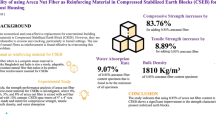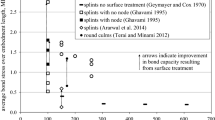Abstract
Fiber hybridization is one of the prominent techniques which offers a balanced distribution of attributes as well as an option to employ natural fibers without compromising functionality by decreasing environmental impact. The hybrid sustainable composites were fabricated with combination of two distinct natural fiber mats (kenaf (K) and bamboo (B)) and polylactic acid (PLA) through the compression molding method. Ten different stacking sequences were prepared and tested under ASTM International standards by maintaining a fiber matrix ratio of 30:70. The experimental outcomes demonstrated that the arrangement of fiber mats under different stacking sequences significantly affects the mechanical and water absorption properties of the developed hybrid composites. A rise in water absorption percentage was observed with the addition of kenaf layer due to its more hydrophilic nature. Among the different stacking sequences tested, K/B/B/K yielded a maximum tensile strength of 43.59 MPa, B/K/K/B yielded a maximum flexural strength of 75.78 MPa, and K/K/K/K yielded a maximum impact energy of 40.56 kJ/m2 with a maximum hardness of 62.5. Morphological analysis of the fractured samples was performed to observe the microstructural variations and their bonding at the interfaces of the respective hybrid composites. Using the analysis of variance (ANOVA), it is seen that stacking sequence plays a vital part in scheming the characteristics. The overall evaluation criteria (OEC) were formulated to obtain the optimum stacking sequence by bringing the mechanical characteristics into a single index. From the ANOVA of OEC, it is justified that hybridization is found to be one of the significant methods to achieve mechanical properties. This study also provides an understanding of sustainable novel hybrid laminated natural composites for roofing structural applications in terms of physical and mechanical characteristics.










Similar content being viewed by others
Data availability
All data generated or analyzed during this study are included in this article.
References
Khan MZ et al (2018) Tensile and flexural properties of natural fiber reinforced polymer composites: a review. J Reinf Plast 37(24):1435–1455
Chandgude S et al (2021) In state of art: Mechanical behavior of natural fiber-based hybrid polymeric composites for application of automobile components. Polym Compos 42(6):2678–2703
Laurent A et al (2012) Limitations of carbon footprint as indicator of environmental sustainability. Environ Sci Technol 46(7):4100–4108
Salman SD et al (2016) Tension-compression fatigue behavior of plain woven kenaf/kevlar hybrid composites. BioResour 11(2):3575–3586
Ghanbarzadeh B, Almasi H (2013) Biodegradable polymers. In: Biodegradation - life science. IntechOpen, pp 141–185
Moshood TD et al (2022) Biodegradable plastic applications towards sustainability: a recent innovations in the green product. Clean Eng Technol 6:100404
Bhagabati P (2020) Biopolymers and biocomposites-mediated sustainable high-performance materials for automobile applications. In: Sustainable nanocellulose and nanohydrogels from natural sources. Elsevier, pp 197–216. https://doi.org/10.1016/B978-0-12-816789-2.00009-2
Mohammed et al (2015) A review on natural fiber reinforced polymer composite and its applications. Int J Pol Sci. https://doi.org/10.1155/2015/243947
Patti A et al (2020) Eco-sustainability of the textile production: waste recovery and current recycling in the composites world. Polym 13(1):134
Ahmad Nadzri SNZ et al (2020) A review on the kenaf/glass hybrid composites with limitations on mechanical and low velocity impact properties. Polym 12(6):1285
Salman SD et al (2016) Influence of fiber content on mechanical and morphological properties of woven kenaf reinforced PVB film produced using a hot press technique. Int J Polym Sci. https://doi.org/10.1155/2016/7828451
Ochi S (2008) Mechanical properties of kenaf fibers and kenaf/PLA composites. Mech Mater 40(4–5):446–452
Akil H et al (2011) Kenaf fiber reinforced composites: a review. Mater Des 32(8–9):4107–4121
Cristaldi G et al (2010) Composites based on natural fiber fabrics. Woven Fabric Eng 17:317–342
Nkeuwa WN et al (2022) Bamboo-based composites: a review on fundamentals and processes of bamboo bonding. Compos Part B: Eng 235:109776
Porras A, Maranon A (2012) Development and characterization of a laminate composite material from polylactic acid (PLA) and woven bamboo fabric. Compos Part B: Eng 43(7):2782–2788
Morales P et al (2017) Bamboo–polylactic acid (PLA) composite material for structural applications. Mater 10(11):1286
Khoshnava SM et al (2017) Woven hybrid biocomposite: mechanical properties of woven kenaf bast fiber/oil palm empty fruit bunches hybrid reinforced poly hydroxybutyrate biocomposite as non-structural building materials. Constr Build Mater 154:155–166
Ejaz M et al (2020) Mechanical and biodegradable properties of jute/flax reinforced PLA composites. Fibers Polym 21:2635–2641
Pappu A et al (2019) Manufacturing and characterization of sustainable hybrid composites using sisal and hemp fibers as reinforcement of poly (lactic acid) via injection moulding. Ind Crops Prod 137:260–269
Asaithambi B et al (2014) Bio-composites: development and mechanical characterization of banana/sisal fiber reinforced poly lactic acid (PLA) hybrid composites. Fibers Polym 15:847–854
Kwon HJ et al (2014) Tensile properties of kenaf fiber and corn husk flour reinforced poly (lactic acid) hybrid bio-composites: role of aspect ratio of natural fibers. Compos Part B: Eng 56:232–237
Khan T et al (2021) The effects of stacking sequence on the tensile and flexural properties of kenaf/jute fiber hybrid composites. J Nat Fibers 18(3):452–463
Safwan A et al (2018) Preliminary study on tensile and impact properties of kenaf/bamboo fiber reinforced epoxy composites. J Renew Mater 6(5):529–535
Ismail AS et al (2019) void content, tensile, vibration and acoustic properties of kenaf/bamboo fiber reinforced epoxy hybrid composites. Mater 12(13):2094
Ismail AS et al (2019) Physical and mechanical properties of woven kenaf/bamboo fiber mat reinforced epoxy hybrid composites. BioResour 14(1):1390–1404
Sadashiva K et al (2023) Physical and mechanical properties of bio based natural hybrid composites. J Mater Environ Sci 14(1):131–140
Islam MZ et al (2024) Experimental investigation of mechanical properties of jute/hemp fibers reinforced hybrid polyester composites. SPE Polymers. https://doi.org/10.1002/pls2.10119
Boopathi S et al (2023) Influences of various natural fibers on the mechanical and drilling characteristics of coir-fiber-based hybrid epoxy composites. Eng Res Exp 5(1):015002
Ahmad S et al (2023) Experimental investigation of mechanical properties and morphology of bamboo-glass fiber-nanoclay reinforced epoxy hybrid composites. Cogent Eng 10(2):2279209
Murariu M et al (2016) PLA composites: from production to properties. Adv Drug Deliv Rev 107:17–46
Vink ETH et al (2003) Applications of life cycle assessment to NatureWorks™ polylactide (PLA) production. Polym Degrad Stab 80(3):403–419
Choudhury MR et al (2020) Experimental analysis of tensile and compressive failure load in single-lap adhesive joint of green composites. Int J Adhes Adhes 99:102557
Hyde A et al (2020) Effects of microvoids on strength of unidirectional fiber-reinforced composite materials. Compos Part B: Eng 187:107844
Mehdikhani M et al (2019) Voids in fiber-reinforced polymer composites: a review on their formation, characteristics, and effects on mechanical performance. J Compos Mater 53(12):1579–1669
Rangaraj SV et al (2000) Effects of moisture on the durability of a wood/thermoplastic composite. J Thermoplast Compos Mater 13(2):140–161
Almansour FA et al (2017) Effect of water absorption on mode I interlaminar fracture toughness of flax/basalt reinforced vinyl ester hybrid composites. Compos Struct 168:813–825
Venkateshwaran N et al (2011) Mechanical and water absorption behaviour of banana/sisal reinforced hybrid composites. Mater Des 32(7):4017–4021
Khairi et al (2015) Removal of toxic mercury from petroleum oil by newly synthesized molecularly-imprinted polymer. Int J Mol Sci 16:10562–10577
Castanet et al (2016) Structure–property relationships of elementary bamboo fibers. Cellulose 23:3521–3534
Saeed et al (2021) Pristine and magnetic kenaf fiber biochar for Cd2+ adsorption from aqueous solution. Int J Environ Res Public Health 18(15):7949
Khalil HA et al (2011) Woven hybrid composites: water absorption and thickness swelling behaviours. BioResour 6(2):1043–1052
Sahu P et al (2022) Water absorption behavior of cellulosic fiber polymer composites: a review on its effects and remedies. J Ind Text 51(5):7480S–7512S. https://doi.org/10.1177/1528083720974424
Maslinda AB et al (2017) Effect of water absorption on the mechanical properties of hybrid interwoven cellulosic-cellulosic fiber reinforced epoxy composites. Compos Struct 167:227–237
Shireesha Y et al (2019) Properties of hybrid composites and its applications: a brief review. Int J Sci Technol Res 8(8):335–341
Vijay R et al (2016) Experimental investigation on the mechanical properties of Cyperus pangorei fibers and jute fiber-based natural fiber composites. Int J Polym Anal 21(7):617–627
Mousavi SR et al (2022) Mechanical properties of bamboo fiber-reinforced polymer composites: a review of recent case studies. J Mater Sci 57(5):3143–3167
El-baky A et al (2020) Mechanical characterization of hybrid composites based on flax, basalt and glass fibers. J Compos Mater 54(27):4185–4205
Martijanti M et al (2021) Polymer composite fabrication reinforced with bamboo fiber for particle board product raw material application. Polym 13(24):4377
Swolfs Y et al (2014) Fiber hybridization in polymer composites: a review. Compos Part A: Appl Sci Manuf 67:181–200
Huang S et al (2021) Characterization of interfacial properties between fiber and polymer matrix in composite materials–a critical review. J Mater Res Technol 13:1441–1484
Sisodia S et al (2015) Effects of voids on quasi-static and tension fatigue behaviour of carbon-fiber composite laminates. J Compos Mater 49(17):2137–2148
Yusoff RB et al (2016) Tensile and flexural properties of polylactic acid-based hybrid green composites reinforced by kenaf, bamboo and coir fibers. Ind crops prod 94:562–573
Vijayakumar A et al (2022) Investigation on the effect of stacking order and hybridization on mechanical and water absorption properties of woven flax/bamboo composites. Polym Compos 43(8):5189–5207
Sanjay MR et al (2018) The hybrid effect of jute/kenaf/E-glass woven fabric epoxy composites for medium load applications: impact, inter-laminar strength, and failure surface characterization. J Nat Fibers 16(4):600–612. https://doi.org/10.1080/15440478.2018.1431828
Manral A et al (2020) Static and dynamic mechanical analysis of geometrically different kenaf/PLA green composite laminates. Polym Compos 41(2):691–706
Chee SS et al (2017) Thermal stability and dynamic mechanical properties of kenaf/bamboo fiber reinforced epoxy composites. BioResour 12(4):7118–7132
Azlin MNM et al (2022) Effect of stacking sequence and fiber content on mechanical and morphological properties of woven kenaf/polyester fiber reinforced polylactic acid (PLA) hybrid laminated composites. J Mater Res Technol 16:1190–1201
Yong CK et al (2015) Effect of fiber orientation on mechanical properties of kenaf reinforced polymer composite. BioResour 10(2):2597–2608
Ahmed MM et al (2021) Enhancement of impact toughness and damage behaviour of natural fiber reinforced composites and their hybrids through novel improvement techniques: a critical review. Compos Struct 259:113496
Ozturk S (2010) Effect of fiber loading on the mechanical properties of kenaf and fiberfrax fiber-reinforced phenol-formaldehyde composites. J Compos Mater 44(19):2265–2288
Marichelvam MK et al (2023) Investigation of mechanical and morphological analysis of natural fiber hybrid composites. Biomass Conv Bioref. https://doi.org/10.1007/s13399-023-04612-z
Hikmat M et al (2021) Investigation of tensile property-based Taguchi method of PLA parts fabricated by FDM 3D printing technology. Results Eng 11:100264
Deka S et al (2021) Machinability of silicon and German silver in micro electrical discharge machining: a comparative study. SILICON 13(4):1065–1077
Singh AK et al (2019) Analysis of micro-rods machined using reverse micro-EDM. J Braz Soc Mech Sci Eng 41(1):15
Kar S et al (2019) Effect of non-electrical parameters in fabrication of micro rod using BEDG. Mater Manuf 34(11):1262–1273
Agyei S et al (2022) Tensile strength and micro-hardness properties of common roofing sheets in Ghana. DJES 15:10–18. https://doi.org/10.24237/djes.2022.15202
Viana QS et al (2022) Physical, mechanical, and thermal properties of concrete roof tiles produced with vermiculite. Environ Sci Pollut Res 29(32):48964–48974
Al-Azad N et al (2021) A review on development of natural fiber composites for construction applications. J Mater Sci Chem Eng 9(7):1–9
Acknowledgements
The authors express their gratitude for the support provided by NIT Meghalaya, Tripura University, and Material Analysis Research Centre, Bengaluru, India, to assist in the completion of this research work.
Author information
Authors and Affiliations
Contributions
Chaiki Malakar: investigation, methodology, and writing—original draft; Ravivarman R: conceptualization, supervision, and writing—review and editing; Vipin Kumar Tripathi: project administration, and writing—review and editing; Kishore Debnath: resources and data curation; Jawahar Paulraj: formal analysis; Padmanaban Velayudhaperumal Chellam: writing—validation, review, and editing.
Corresponding author
Ethics declarations
Conflict of interest
The authors declare no competing interests.
Additional information
Publisher's Note
Springer Nature remains neutral with regard to jurisdictional claims in published maps and institutional affiliations.
Rights and permissions
Springer Nature or its licensor (e.g. a society or other partner) holds exclusive rights to this article under a publishing agreement with the author(s) or other rightsholder(s); author self-archiving of the accepted manuscript version of this article is solely governed by the terms of such publishing agreement and applicable law.
About this article
Cite this article
Malakar, C., R, R., Tripathi, V.K. et al. Agro-based kenaf/bamboo/polylactic acid (KBP) hybrid composites for the structural roofing applications: statistical evaluation of physical and mechanical properties. Biomass Conv. Bioref. (2024). https://doi.org/10.1007/s13399-024-05678-z
Received:
Revised:
Accepted:
Published:
DOI: https://doi.org/10.1007/s13399-024-05678-z




